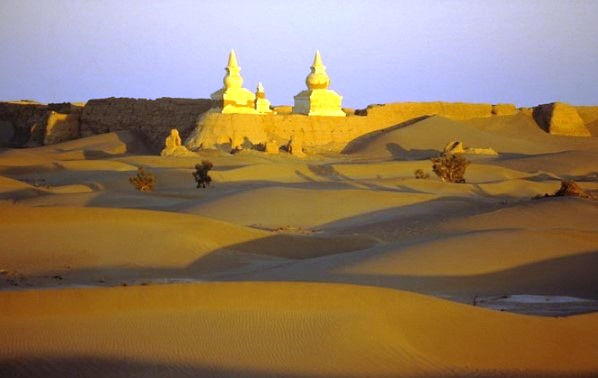Khara-Khoto – The Black City once a prosperous kingdom stood in the middle of the Gobi Desert near the Juyan Lake Basin, at the westernmost tip of Inner Mongolia. The city was a center of religious learning, a center of art, as well as a trading hub. A few shattered mud buildings and scattered sun-bleached bones remain today as the only remnants of the city’s crumbling ramparts.
Mongolians call Khara-Khoto the “black city” and it was founded in 1032 AD when the Western Xia Dynasty (1038-1227) was discovered. When Genghis Khan captured the city in 1226, Khara-Khoto flourished under Mongol rule instead of being trampled to death. As Kublai Khan expanded the city, Marco Polo mentioned it as Etzina in his travelogue, a name given to the city by its Tangut inhabitants:
After leaving Campichu, you ride for twelve days until you reach Etzina, a city on the edge of the Sandy Desert in the Tangut Province, which lies in the north. A number of good falcons, both Sakers and Lanners, are produced in the country, as well as plenty of camels and cattle. As they do not have any trade, the inhabitants rely on farming and cattle. The desert extends forty days to the north until you meet with no habitation or baiting place, so when you leave Etzina, you must lay in victuals for forty days.
The Tangut people lived peacefully under the Mongols for nearly 150 years, until the reign of the Ming dynasty in 1372 brought an end to their peaceful existence. There is no exact reason why Khara-Khoto fell, but local legend claims that Ming rulers diverted the Ejin River, the city’s only water supply, so that the city’s troops and residents could not take advantage of its life-giving water. The people of Khara-Khoto were forced to choose between dying of thirst or facing the Ming soldiers in combat as the Ming troops choked the city without ever setting foot inside its walls.
According to legend, Khara Bator, a Mongol military general, committed suicide after murdering his wife and children. A second version of the rumor suggests that Khara Bator escaped through a breach in the northwest corner of the city wall. During the final attack by the Ming soldiers, they slaughtered not only the remaining population but also all the cattle and horses. In the aftermath of this defeat, Khara-Khoto fell into ruin.
Pyotr Kuzmich Kozlov, a Russian explorer under the command of the Mongol-Sichuan expedition, rediscovered the site in the early 20th century. Tangut manuscripts, scrolls, and books were found during the expedition’s initial excavations. A stupa outside of the city walls contained Buddhist statues, texts, and woodcuts, which were also returned to St. Petersburg. In addition to manuscripts and books, many daily items, production instruments, and religious items were found during further excavations. Tangut language research was largely based on these books and xylographs, written in Tangut script in subsequent years.
The only remaining remnants of this great city are 30-foot-tall ramparts, a few 40-foot-tall pagodas, and what appears to be a Masjid outside the city walls, indicating that there were Muslims among the people ruled by the Tangut.
As far as gobi desert, the great eggs of the long-extinct dinosaurs have been found, and evidence has been uncovered of the existence here of a prehistoric race of men to whom the name dune-dwellers has been given. Most of the desert is easily traversed by motor cars and trucks during the summer months, and there are several caravan routes across it.














